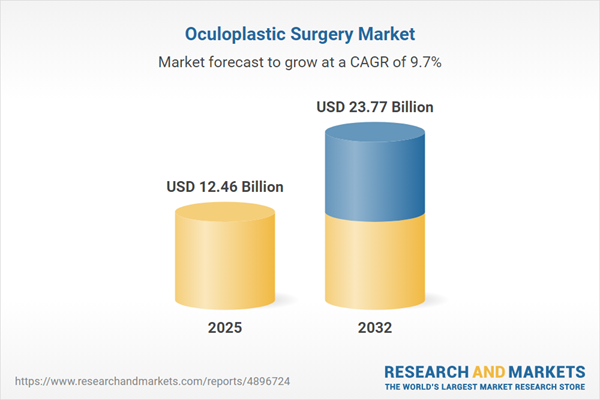Speak directly to the analyst to clarify any post sales queries you may have.
The oculoplastic surgery market is experiencing significant transformation as new technologies, patient-centric care models, and changing regulatory environments reshape industry approaches and priorities. Senior executives require focused, actionable intelligence to anticipate disruption, safeguard their leadership positions, and leverage emerging opportunities in this complex environment.
Market Snapshot: Oculoplastic Surgery Market Size, Growth, and Outlook
In 2024, the oculoplastic surgery market reached USD 11.35 billion, with a compound annual growth rate (CAGR) of 9.67% projected through 2032. Forecasts suggest an increase to USD 12.46 billion by 2025 and, potentially, USD 23.77 billion by 2032. This momentum is powered by growing preference for minimally invasive procedures and widening use of digital health technologies across patient care delivery. Supporting these trends, urban demographic shifts and rising patient expectations are streamlining clinical processes and reinforcing the need for organizational agility. Adapting business strategies to these rapid changes is critical for organizations seeking to maintain market relevance and operational efficiency.
Scope & Segmentation: Comprehensive Oculoplastic Surgery Market Coverage
- Procedure Types: Blepharoplasty, brow lift, dacryocystorhinostomy, orbital reconstruction, and ptosis repair support both reconstructive and cosmetic indications, enabling clinicians to utilize modern surgical techniques to meet varied case requirements.
- Treatment Modalities: Injectables, laser-based systems, and conventional surgical options enhance flexibility for providers, enabling personalization and promoting quicker patient recovery in line with current treatment preferences.
- End Users: Ambulatory surgical centers, oculoplastic clinics, ophthalmology centers, and hospitals play an essential role in market expansion, notably integrating new technology to advance service levels and adapt to evolving models of patient care.
- Product Types: Autografts, allografts, synthetic implants, fillers, sutures, tissue sealants, and updated laser platforms provide essential resources for clinicians, supporting tailored solutions within diverse clinical environments.
- Regional Coverage: The Americas, Europe, Middle East & Africa, and Asia-Pacific each demonstrate unique protocols and approaches, with regional differences in reimbursement, technology uptake, and clinical adoption helping drive distinct growth trajectories.
- Profiles Featured: Prominent organizations such as Carl Zeiss Meditec AG, Lumenis Ltd., AbbVie Inc., Stryker Corporation, IRIDEX Corporation, Revance Therapeutics, Alcon Inc., Johnson & Johnson, NIDEK Co., and Stanford Health Care shape innovation and support elevated standards of care.
Key Takeaways: Strategic Insights for Oculoplastic Surgery Market Leaders
- Modern imaging platforms and next-generation biomaterials are enhancing clinical outcomes and strengthening stakeholder confidence throughout complex procedures.
- Rising demand for less invasive surgery is streamlining operational workflows, improving patient experience, and enabling providers to adapt efficiently within specialized care environments.
- Collaboration between clinical, technical, and administrative teams supports ongoing adjustments to new care models, ensuring seamless transitions during regulatory or procedural changes.
- Navigating regulatory differences and responding effectively to reimbursement updates are enabling organizations to minimize risk exposure and identify targeted growth opportunities.
- Strategic partnerships with academic and research entities accelerate the pace of protocol innovation, ensuring best practices remain aligned with evolving global standards.
- Operational resilience hinges on responsive management systems designed for adaptable compliance and proactive response to ongoing market and policy changes.
Tariff Impact: Navigating Recent US Tariff Changes
Recent US-imposed tariffs affecting laser diodes and biomaterials are prompting many companies to reevaluate procurement strategies and adjust their supply chain configurations. Emphasizing local sourcing options and reinforcing supplier partnerships have become key priorities to ensure reliable product access and retain high service quality under market pressures. Cross-functional coordination among procurement, operations, and clinical teams has gained importance to ensure stability as organizations adapt to these changes.
Methodology & Data Sources
This report is grounded in interviews with sector leaders, data from regulatory filings, clinical research findings, and academic studies. Analytical frameworks such as PESTLE and Porter’s Five Forces were utilized for objective risk analysis and identification of growth opportunities within the oculoplastic surgery market.
Why This Report Matters: Data-Driven Strategies for Senior Executives
- Empowers leadership to proactively respond to ongoing sector transformation, positioning organizations to stay ahead through market shifts.
- Delivers actionable insights and structured segmentation to help navigate regulatory complexity and sustain operational agility.
- Enhances executive decision-making, supporting effective resource allocation and preparedness for evolving commercial and healthcare delivery trends.
Conclusion
Carefully investing in workforce capacity and technological preparedness is essential for continued competitiveness. Applying this analysis helps organizations maintain adaptability and resilience as the oculoplastic surgery market continues to evolve.
Additional Product Information:
- Purchase of this report includes 1 year online access with quarterly updates.
- This report can be updated on request. Please contact our Customer Experience team using the Ask a Question widget on our website.
Table of Contents
3. Executive Summary
4. Market Overview
7. Cumulative Impact of Artificial Intelligence 2025
Companies Mentioned
The companies profiled in this Oculoplastic Surgery market report include:- Carl Zeiss Meditec AG
- Lumenis Ltd.
- AbbVie Inc.
- Stryker Corporation
- IRIDEX Corporation
- Revance Therapeutics, Inc.
- Alcon Inc.
- Johnson & Johnson
- NIDEK Co., Ltd.
- Stanford Health Care
Table Information
| Report Attribute | Details |
|---|---|
| No. of Pages | 197 |
| Published | November 2025 |
| Forecast Period | 2025 - 2032 |
| Estimated Market Value ( USD | $ 12.46 Billion |
| Forecasted Market Value ( USD | $ 23.77 Billion |
| Compound Annual Growth Rate | 9.6% |
| Regions Covered | Global |
| No. of Companies Mentioned | 11 |









